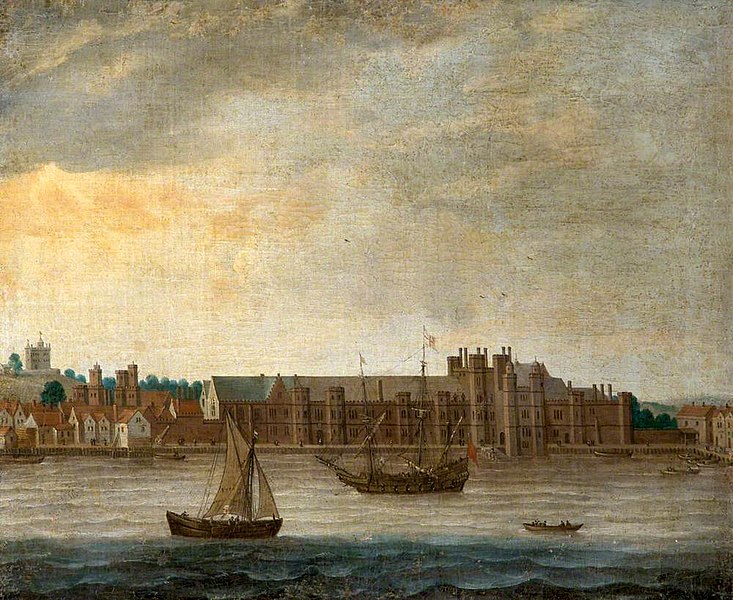I am happy to be a part of this wonderful blog series. When I was writing On the Trail of the Yorks, I became fascinated with Margaret of York. She was such a strong woman. I hope you enjoy this excerpt about Margaret’s visit to England.
The youngest surviving daughter of Richard and Cecily, Margaret was born 3 May 1446. She was closest in age to her siblings George and Richard. Her early life was overshadowed by the conflict between her father and the king, and she was still unmarried when her father died. When her brother became king, her marriage, unlike that of her sisters, was arranged as befitting an English princess. Eventually marrying the Duke of Burgundy, Margaret proved loyal to both her family and her husband’s duchy. She was respected and admired, even by her stepson-in-law.
Palace of Placentia, Greenwich, Kent

British (English) School; View of the Thames with the Old Palace of Placentia at Greenwich, London; National Trust, Kingston Lacy; http://www.artuk.org/artworks/view-of-the-thames-with-the-old-palace-of-placentia-at-greenwich-london-100585
Once Edward became king, Margaret stayed largely at Greenwich. She, along with Richard and George, were housed there and provided for by the king. Thomas Beaufort had been given an estate here by Henry V, but after his death it was given to Humphrey, Duke of Gloucester, who rebuilt the home and enclosed the park. In 1433, he received a licence to crenellate the house. Humphrey’s built a stone and timber manor house, with a limestone tower. The palace, including the gardens, courtyards, and 200 acre park, extended from the rolling waters of the Thames to the foot of the hill, on top of which he built a stone tower. Following Humphrey’s death, the home was given to Margaret of Anjou, who renamed it Placentia or Pleasaunce.
Margaret and Henry each had a ward in the house. The queen’s ward contained a large chamber, a parlour and a gallery, overlooking the queen’s garden. Henry VI constructed a brick wall between the home and the mighty waters of the Thames.
During the first few years of his reign, Edward IV enlarged the palace and stocked the park with deer. Margaret, George and Richard probably spent time hunting in the park. The first Christmas after becoming king, Edward celebrated at Greenwich with his younger siblings. As the anniversary of their father’s death approached, the family may have held their father’s first year’s mind here in the chapel. Despite later troubles, the family seems to have been close. Eventually Edward granted the palace to his wife, Elizabeth.
Margaret’s Visit to England and Greenwich
In 1480, Margaret returned to England as part of an embassy to her brother trying to draw Edward into an Anglo-Burgundian alliance against France. Edward Woodville, James Radcliff and other members of Edward’s household were sent to Calais to escort Margaret home. Scofield says the men, wearing their jackets of ‘purple and blue velvet’ brought Margaret across the Channel on the Falcoln. At Gravesend, Margaret boarded the royal barge, with the master and twenty-four bargemen decked out in their new jackets of murrey and blue, embellished with roses. The king also provided ‘green velvet, garnished with aglets of silver gilt, bordered with spangles, for horse harnesses, together with crimson velvet for covering head-stalls and reins for ten hobies and palfreys’ for his sister’s procession.
Arriving at the Greenwich, Margaret was given luxurious chambers. Intricately woven tapestries depicting the story of Paris and Helen hung within the chambers that had been fitted for Margaret. Her feather bed had a valence of velvet. Pieces of woven wool tapestry covered the table containing the images of ‘roses, sunnes and crowns’.
A large state dinner was given in honour of Margaret and her mother, Cecily. While both Edward and Richard were in attendance, along with Elizabeth, Duchess of Suffolk, one brother was conspicuously absent. Margaret seems to have favoured George, who by this time had already been executed. At one point she had opened discussions of a marriage between George and her stepdaughter Mary. However, there were also new nieces and nephews for Margaret to meet. She stayed in England for about three months. During that time, she was housed at both Greenwich and Coldharbour.

